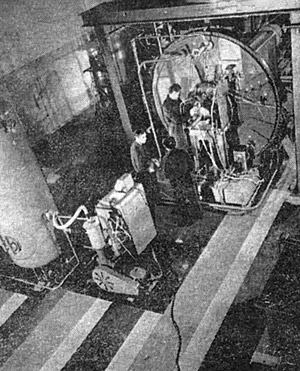
Electronic english version since 2022 |
The newspaper was founded in November 1957
| |
WHAT did the newspaper write about that day?
52 years ago
No. 23 (1744) of 28 March, 1972
***
At the next lesson of the evening faculty "Likbez", organized by the council of young scientists, they discussed the issue of the identity of particles in quantum mechanics. It was held by one of the most popular lecturers of the Joint Institute M.I.Podgoretsky. The seminar was held, as usual, in the cafe "Ogonek" and lasted about five hours. The listeners left extremely reluctantly. At the previous classes of "Likbez", L.M.Soroko had spoken about holography and the rapidly developing branch of applied mathematics - Walsh functions. In the future, V.I.Ogievetsky ("Issues of symmetry in quantum field theory") and L.I.Ponomarev ("Some issues of quantum mechanics") agreed to speak at the seminar.
***
On powerful advanced accelerators with high particle intensities, a significant part of research both in the field of elementary particle physics and in the field of atomic nuclear physics is carried out using radio electronics techniques. The fate of individual relevant research and the level of work in entire areas depend on the perfection of electronic techniques and the speed of preparation of electronic equipment.
According to DLNP Deputy Director L.I.Lapidus, for a number of years, each group of the laboratory has independently resolved the issue of developing electronic techniques. Three years ago, after considering issues of standard electronics, the required "electronic construction kit" was developed. Today, there are no longer any experiments at the synchrocyclotron that would require independent development of nanosecond electronics. V.G.Zinov's sector, relying on the support of the entire laboratory and using TsEM products, provided almost all electronic experiments with reliable and advanced nanosecond electronics. This is an important result, its significance is easy to sense even for non-specialists.
 |
| One of the main components of the IBR-2 reactor prototype is installed in the experimental hall of the physics building of the Laboratory of Neutron Physics. Designers, engineers and physicists are testing a moving reflector |
The technique of physical experimentation changes rapidly. The time has come when the DLNP physicists have discovered that it was impossible to work while remaining on the old positions regarding nanosecond electronics. The way out of this situation was found in the concentration of departmental efforts, in the clear and precise support of physicists and the laboratory Directorate. As Head of the sector V.G.Zinov said, "The result is significant. A system of nanosecond logic units has been developed, that is, introduced into mass production and physicists received over a thousand units of 25 names. From the very beginning, we refused to achieve record results in all respects. The main thing was to provide first of all the basic needs of the physical experiment. We had to dramatically change our approach to new developments, reliability, documentation and information. Physicists are rewarded for their patience. They got their hands on a reliable and high-quality construction set with a diverse complex of components. This is evidenced by the result of operation. We do not need to redo what we have done; none of the units have been discontinued. It is also pleasant to note that each employee has made a significant contribution to this work. The system of nanosecond logic units is the sum of the knowledge, perseverance and experience of engineers V.F.Boreyko, Yu.G.Budyashov, Y.M.Valueva, V.M.Grebenyuk, B.S.Krasnoborodov... The mass production of units was established by the CEM group, where we always met with understanding and support."
***
Dr. Wolfgang Kluge (INP, Karlsruhe) arrived in the sector of DRSC headed by V.I.Petrukhin (DLNP) through the scientific exchange between JINR and CERN. This is his second time in Dubna. Previously, W.Kluge studied nuclear reactions at high energies at the synchrocyclotron. Dr. Kluge will carry out further research in this area, participate in the group's work and discuss the possibility of implementing joint experiments in the future. Of greatest interest to the physicist from Germany are experiments on three-particle reactions that are carried out in the laboratory.
Head of the column Irina LEONOVICH,
photo by Yury TUMANOV